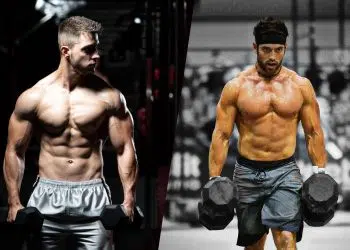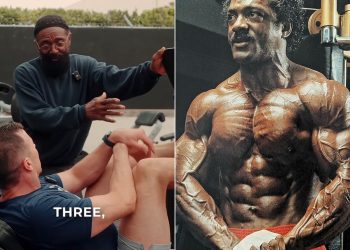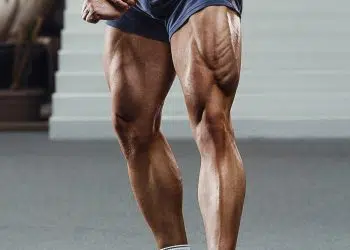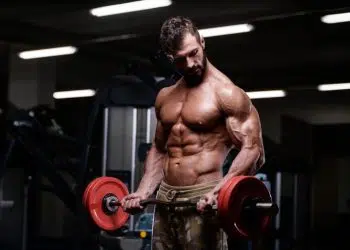The barbell back squat is the king of leg exercises; hardcore gymgoers revere it. However, it has its problems. The biggest among them is that it excessively compresses the spine.
Some back squat alternatives work the quads, glutes, and hamstrings without compromising your spine. This article lists the 11 best back squat alternatives you should add to your exercise arsenal.
Back Squat Muscles Worked

The primary muscles worked with the back squat are:
Quadriceps
The quadriceps extend the knee like the triceps extend the elbow. The quadriceps have four heads. On a developed body, only three of them are discernible:
- Vastus lateralis
- Vastus medialis
- Rectus femoris
The quadriceps’ four heads meet at the quadricep tendon, which is situated slightly above the knee, then proceed down the patella to the tibia, or lower leg bone, where they insert.
Level Up Your Fitness: Join our 💪 strong community in Fitness Volt Newsletter. Get daily inspiration, expert-backed workouts, nutrition tips, the latest in strength sports, and the support you need to reach your goals. Subscribe for free!
Three of the four heads originate at the tip of the thigh bone(femur). The rectus femoris, the fourth head, passes the hip joint and originates on the pelvis.
Hamstrings
The hamstrings are a group of four muscle heads located on the back of the thigh. They include:
- Short head of the biceps femoris
- Long head of the biceps femoris
- Semimembranosus
- Semitendinosus
These four heads cooperate to achieve knee flexion. Your heel is brought back and up towards the butt with this motion. Although the glutes are the primary muscle in this task, the hamstrings provide a supporting role by helping the hips extend.
Glutes
The glutes consist of three muscles. The gluteus maximus is the biggest and strongest muscle of the three and originates on the posterior edge of the pelvis, adjacent to the spine. While some fibers attach to the iliotibial tract outside the thigh, others insert onto the top of the femur.
The gluteus medius and gluteus minimus are the other two gluteal muscles. These two lie underneath the gluteus maximus.
The upper leg bone (femur) is moved down and back by the gluteus maximus when the hip joint extends.
How To Perform the Back Squat
The back squat is a functional movement and is often performed incorrectly. Often the problem arises from trying to lift too heavy. Begin with a relatively light weight that lets you learn the proper form.
Steps:
- Stand in front of a loaded barbell in a squat rack with your feet shoulder-width apart.
- Position yourself under the bar set at shoulder height.
- Take a step back and assume a shoulder-wide stance; turn your toes slightly outward.
- Keeping your chest up, push your hips back and lower your body as if sitting in a chair.
- Go down until your thighs are at least parallel to the floor.
- Drive through your heels to return to the start position.
- Repeat for recommended reps.
Pro tips:
- Keep your heels pressed into the floor.
- Maintain an upright torso (do not round your back).
- Keep the bar at the upper trapezius/shoulder level.
- Push your knees out as you come out of the hole.
Benefits:
- Builds muscle mass in the quads
- Develops lower body strength
- Promotes the release of growth hormone
This Exercise:
- Target Muscle Group: Quadriceps
- Secondary Muscles: Glutes and Hamstrings
- Type: Strength
- Mechanics: Compound
- Equipment: Barbell
- Difficulty: Intermediate
- Best Rep Range:
- Hypertrophy: 8-12
- Strength: 1-5
11 Best Back Squat Alternatives
Given below are the eleven best back squat alternatives:
1. Dumbbell Goblet Squat
With the dumbbell goblet squat, you can load your quads without loading your spine. Holding the dumbbell in front of your body keeps your torso upright.
Steps:
- Stand with your feet shoulder-width apart.
- Hold a dumbbell vertically with your hands cupped under the top end of it. The weight should be resting against your chest.
- Inhale as you lower into a squat. Maintain a neutral spine and keep your torso upright.
- Stop when your elbows touch your knees and push through the heels to return to the start position.
Pro tip: You can hold the dumbbell from its handle if it feels more comfortable.
Benefits of the dumbbell goblet squat:
- No spinal compression
- Allows for a more upright torso position
This Exercise:
- Target Muscle Group: Quadriceps
- Secondary Muscles: Glutes, hamstrings
- Type: Strength
- Mechanics: Compound
- Equipment: Dumbbell
- Difficulty: Intermediate
- Best Rep Range:
- Hypertrophy: 8-12
- Strength: 1-5
2. Dumbbell Squat
The dumbbell squat allows you to load your lower body without compressing your spine. This exercise is safer than the barbell back squat. Drop the dumbbells if you fail during a rep.
Steps:
- Stand with your feet shoulder-width apart, with your hands at your sides.
- Grab a dumbbell in each hand with a neutral grip.
- Lower yourself into a squat until your quads are parallel to the floor. Maintain a natural arch in your lower back.
- Driving through your heels, return to the start position.
- To maintain tension in the quads, halt short of lockout at the top.
- Repeat.
Pro tip: Use wrist wraps while lifting heavy to eliminate your grip strength and focus on your quads.
Benefits of the dumbbell squat:
- Loads the quads without spinal compression
- Safer than the barbell squat
This Exercise:
- Target Muscle Group: Quadriceps
- Secondary Muscles: Glutes and Hamstrings
- Type: Strength
- Mechanics: Compound
- Equipment: Dumbbells
- Difficulty: Intermediate
- Best Rep Range:
- Hypertrophy: 8-12
- Strength: 1-5
3. Bulgarian Split Squat
The Bulgarian Split Squat allows you to load your quads one leg at a time. This exercise will also improve your coordination and balance.
Steps:
- Stand about two feet in front of a bench.
- Place the top of your right foot on the bench.
- Hold a pair of dumbbells at your sides. Your rear leg should be slightly bent.
- Lower toward the floor by bending at your knees. The rear knee should be a few inches off the floor at the bottom.
- Push through the front heel to return to the start position.
Pro tip: Do not let your knee extend over your toes during this exercise.
Benefits of the Bulgarian split squat:
- The unilateral leg exercise fixes muscle and strength imbalances
- Improves balance and coordination
This Exercise:
- Target Muscle Group: Quadriceps
- Secondary Muscles: Glutes and Hamstrings
- Type: Strength
- Mechanics: Compound
- Equipment: Dumbbells
- Difficulty: Intermediate
- Best Rep Range:
- Hypertrophy: 8-12
- Strength: 1-5
Read also: Bulgarian split squat alternatives for stronger legs
4. Dumbbell Lunge
The dumbbell lunge is a functional exercise that works the quads, glutes, and hamstrings. This unilateral exercise allows you to focus on each limb separately.
Level Up Your Fitness: Join our 💪 strong community in Fitness Volt Newsletter. Get daily inspiration, expert-backed workouts, nutrition tips, the latest in strength sports, and the support you need to reach your goals. Subscribe for free!
Steps:
- Stand with your feet shoulder-width apart and a pair of dumbbells held at arm’s length.
- Take a giant step forward with your left foot.
- Lower into a lunge while maintaining an upright torso. Bring your rear knee down to about an inch off the floor.
- Push through the front heel to return to the start position.
Pro tip: To target your quads, perform the forward lunge as described above. To switch the emphasis to the hamstrings, perform a backward lunge by stepping backward.
Benefits of the dumbbell lunge:
- Unilateral exercise for even strength and muscle development
This Exercise:
- Target Muscle Group: Quadriceps
- Secondary Muscles: Glutes and Hamstrings
- Type: Strength
- Mechanics: Compound
- Equipment: Dumbbells
- Difficulty: Intermediate
- Best Rep Range:
- Hypertrophy: 8-12
- Strength: 1-5
5. Leg Extension
The leg extension isolates your quadriceps through their full range of motion. It produces an intense quad burn, promoting hypertrophy and strength increase.
Steps:
- Sit on a leg extension machine and select the appropriate weight. Place your feet under the ankle pads and lean back on the seat. Grab the handles.
- Extend your knees to straighten your legs. Stop just short of lockout.
- Lower back down, stopping just short of the start position.
Pro tip: By cutting out the top and bottom 10 percent of the movement, you can keep constant tension on the quads throughout your entire set.
Benefits of the leg extension:
- Isolates the quads
- No spinal compression
This Exercise:
- Target Muscle Group: Quadriceps
- Type: Strength
- Mechanics: Compound
- Equipment: Leg extension machine
- Difficulty: Intermediate
- Best Rep Range:
- Hypertrophy: 8-12
- Strength: 1-5
6. Cable Squat
The cable squat is a squat variation that allows you to load the quads without compressing the spine. This exercise also allows you to vary the angle of resistance so that it aligns with the direction of the muscle fibers.
Steps:
- Stand in front of a cable pulley machine and set it at its lowest setting.
- Grab the straight handlebar with an overhand grip and stand about three feet away from the pulley, facing it.
- Lower yourself by pushing your hips back and down until your quads are parallel to the floor.
- Push through your heels to return to the start position.
Pro tip: Experiment with a block or slant board under your heels to improve your range of motion.
Benefits of the cable squat:
- Eliminates spinal load
- The direction of resistance matches the muscle fiber direction
This Exercise:
- Target Muscle Group: Quadriceps
- Secondary Muscles: Glutes, hamstrings
- Type: Strength
- Mechanics: Compound
- Equipment: Cable machine
- Difficulty: Intermediate
- Best Rep Range:
- Hypertrophy: 8-12
- Strength: 1-5
7. Leg Press
The leg press is a quad-focused movement that allows you to push heavy weights relatively safely. Getting the most out of this exercise requires you to bring your knees as close to your chest as possible. So don’t go so heavy that your range of motion is compromised.
Steps:
- Load the plates onto a 45-degree leg press machine and sit on the seat. Grab the handles and place your feet on the foot platform, shoulder-width apart.
- Unrack the foot platform and draw your knees toward your chest.
- Press your heels into the platform and push back to the starting position.
Pro tip: Lower the weight under control, taking 2-3 seconds on the eccentric motion.
Benefits of the leg press:
- It allows you to load the quads with a lot of weight safely
This Exercise:
- Target Muscle Group: Quadriceps
- Secondary Muscles: Glutes and Hamstrings
- Type: Strength
- Mechanics: Compound
- Equipment: Leg press machine
- Difficulty: Intermediate
- Best Rep Range:
- Hypertrophy: 8-12
- Strength: 1-5
8. Resistance Band Squat
The resistance band squat is a great squat variation to do at home.
Steps:
- Stand with your feet shoulder-width apart.
- Loop a resistance band under your mid feet and hold the other ends in your hands at shoulder width.
- Lower yourself by pushing your hips back and down.
- Your quads should be at least parallel to the floor at the bottom.
- Drive through your heels to return to the start position.
Pro tip: You can increase the band resistance by spreading your feet further apart.
Benefits of the resistance band squat:
- It is a safe, low-cost squat variation
This Exercise:
- Target Muscle Group: Quadriceps
- Secondary Muscles: Glutes and Hamstrings
- Type: Strength
- Mechanics: Compound
- Equipment: Resistance band
- Difficulty: Intermediate
- Best Rep Range:
- Hypertrophy: 8-12
- Strength: 1-5
9. Jefferson Squat
The Jefferson Squat is an excellent exercise to improve your strength off the floor.
Steps:
- Place the bar on the floor and straddle it in the middle.
- Squat down and grasp the bar by placing one hand in front of your body and the other behind you.
- Drive through your heels to stand up.
- Keep your chest up and your back and head straight. Bend your knees as you lower the bar to the starting position.
Pro tip: Maintain an upright torso, and don’t have your feet too far apart.
Benefits of the Jefferson squat:
- It helps develops power off the floor
This Exercise:
- Target Muscle Group: Quadriceps
- Secondary Muscles: Glutes and Hamstrings
- Type: Strength
- Mechanics: Compound
- Equipment: Barbell
- Difficulty: Intermediate
- Best Rep Range:
- Hypertrophy: 8-12
- Strength: 1-5
10. Pistol Squat
The pistol squat is a bodyweight exercise you can do at home without equipment. This unilateral exercise is a challenging move that will develop strength and power while improving balance and coordination.
Steps:
- Stand upright with your feet shoulder-width apart.
- Raise one leg in front of your body as you push your hips backward and flex the standing leg into a squat.
- You can allow your arms to go out to the sides or in front of you to help you balance.
- Lower the hips as far as possible while keeping the front leg almost parallel to the floor.
- Explode back to the starting position.
Pro tip: You could hold onto a secure upright object, such as a chair, for support as you do this exercise.
Benefits of the pistol squat:
- No equipment is required.
- It helps develops strength, power, balance, and coordination.
This Exercise:
- Target Muscle Group: Quadriceps
- Secondary Muscles: Glutes and Hamstrings
- Type: Strength
- Mechanics: Compound
- Equipment: None
- Difficulty: Intermediate
- Best Rep Range:
- Hypertrophy: 8-12
- Strength: 1-5
11. Smith Machine Front Squat
The Smith machine front squat makes it easier to balance the barbell than the barbell front squat. It emphasizes the quads more during the exercise’s concentric part. This is a good option for beginners who may have difficulty staying upright during the barbell front squat.
Steps:
- Position a Smith machine bar at shoulder level.
- Load appropriate weight and position yourself under the bar, resting it across your upper chest and clavicles.
- Cross your arms over your chest to hold the bar.
- Descend into a parallel squat.
- Push through your heels to return to the start position.
Pro tip: Ensure that the bar’s safety catches are pulled back before beginning the squat.
Benefits of the wide-grip bench press:
- You don’t need to balance the bar
- You are less likely to round your back
This Exercise:
- Target Muscle Group: Quadriceps
- Secondary Muscles: Glutes and Hamstrings
- Type: Strength
- Mechanics: Compound
- Equipment: Smith machine
- Difficulty: Intermediate
- Best Rep Range:
- Hypertrophy: 8-12
- Strength: 1-5
FAQs
Will squats get rid of butt fat?
No, squats will not get rid of butt fat. You cannot spot reduce body fat. The only way to get rid of butt fat is to establish a daily caloric deficit by reducing calorie consumption and doing cardio to burn calories. It will force the body to use stored fat to meet the energy shortfall. That fat will be drawn from all over the body, including the butt.
Is it good to squat with elevated heels?
Many find it beneficial to squat with elevated heels as it allows them to maintain a more upright torso. The raised heels also allow you to squat deeper by improving your range of motion. It helps activate the vastus medialis, also known as the teardrops.
Is it safe to squat bare feet?
Training bare feet in terms of actual muscle biomechanics, foot stability, or ground force is entirely safe. However, squatting barefoot can limit your range of motion and ankle dorsiflexion.
Stand on a slant board or place a pair of weight plates under your heels if you want to square bare feet. It will help achieve a better range of motion.
More alternative exercises:
- Front Squat Alternatives
- Barbell Squat Alternatives
- Smith Machine Squat Alternatives
- Hanging Leg Raise Alternatives
- Sissy Squat Alternatives
- The Best Home Squat Alternatives
- Smith Machine Squat Alternatives
- Best Hack Squat Alternative
- Leg Extension Alternatives
Wrapping Up
The back squat is a compound exercise that helps develop size and strength in the quads, glutes, and hamstrings. But it’s not for everyone. If you’ve got lower back issues or can’t squat without rounding your back, you may be better off doing an alternative that doesn’t compress your spine.
Give each of these back squat alternatives a try, and settle on the three or four that give you the best lower body pump. Combine them into a 12-16 set workout, using a 6-15 rep range for optimal hypertrophy.
Interested in measuring your progress? Check out our strength standards for Bench Press, Smith Machine Squat, Bulgarian Split Squat, and more.











